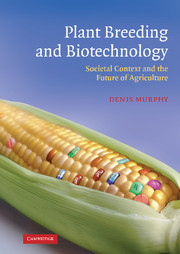Book contents
- Frontmatter
- Contents
- Preface
- Acknowledgements
- Using this book
- Nomenclature and terminology
- Abbreviations and glossary
- Introduction
- Part I The science of plant breeding
- Part II The societal context of plant breeding
- Part III Turmoil and transition: the legacy of the 1980s
- Part IV The agbiotech paradigm
- 11 Agbiotech: genes and dreams
- 12 The future of transgenic crops I: improving the technology
- 13 The future of transgenic crops II: improving the products
- Part V Increasing global crop production: the new challenges
- Part VI Plant breeding in the twenty-first century
- Notes
- References
- Index
11 - Agbiotech: genes and dreams
Published online by Cambridge University Press: 07 May 2010
- Frontmatter
- Contents
- Preface
- Acknowledgements
- Using this book
- Nomenclature and terminology
- Abbreviations and glossary
- Introduction
- Part I The science of plant breeding
- Part II The societal context of plant breeding
- Part III Turmoil and transition: the legacy of the 1980s
- Part IV The agbiotech paradigm
- 11 Agbiotech: genes and dreams
- 12 The future of transgenic crops I: improving the technology
- 13 The future of transgenic crops II: improving the products
- Part V Increasing global crop production: the new challenges
- Part VI Plant breeding in the twenty-first century
- Notes
- References
- Index
Summary
Dreams are nothing but incoherent ideas, occasioned by partial or imperfect sleep.
Benjamin Rush (1746–1813), American physician and CongressmanIntroduction
In the next three chapters, we will take a critical look at the past performance and future prospects of that putative emblem of twenty-first century agriculture: namely agbiotech. In Part 1, we saw how this technology has come to dominate the thinking of many scientists, business people, policymakers, and others with an interest in plant breeding. The technology helped to spawn a dramatic resurgence of private sector interest in the commercial exploitation of crop breeding. But are the revolutionary claims of the agbiotech boosters really justified, or is this just another technology that has been artificially assisted by a fortuitous congruence of favourable patent protection and an ongoing decline in public sector breeding? Is the current agbiotech paradigm really a globally appropriate method of crop improvement? And are agbiotech strategies entitled to an ever increasing share of the limited resources available to international breeding programmes? In Part 1, we will examine these issues in detail, beginning in this chapter with a brief overview of the evolution of the agbiotech concept and development of the industry until the present day.
Agbiotech, or agricultural biotechnology, can be defined as the use of DNA-based technologies for crop improvement. Agbiotech is normally regarded as the development and use of transgenic crops.
- Type
- Chapter
- Information
- Plant Breeding and BiotechnologySocietal Context and the Future of Agriculture, pp. 157 - 177Publisher: Cambridge University PressPrint publication year: 2007



